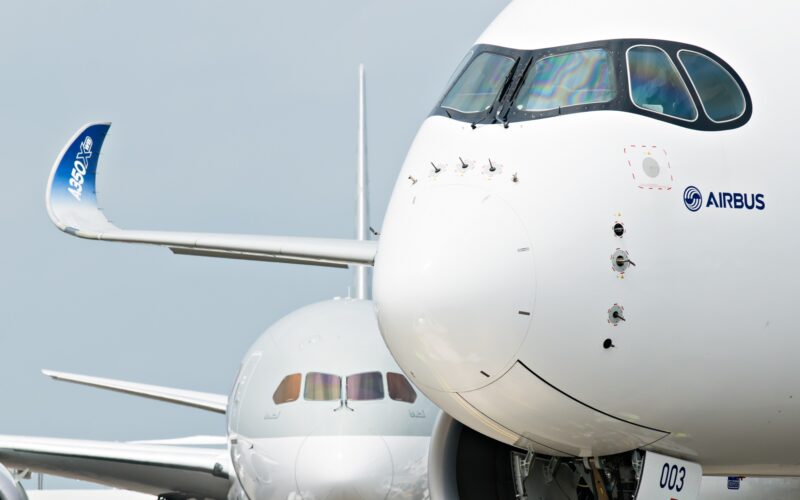Airbus has retained its position as the number one aircraft manufacturer globally, despite attempts by rival Boeing to deliver as many aircraft as possible by the end of the year.
Airbus strengthening positions
Overall, Airbus delivered 661 commercial aircraft throughout 2022, registering 1,078 gross new orders. At the end of the year, the Toulouse, France-based manufacturer’s backlog stood at 7,239 aircraft, as demand for commercial aircraft continued to pick up yearly following 2020. Compared to a year prior, Airbus delivered 50 more aircraft and booked 313 more orders, increasing its backlog by 177 airplanes.
Its most popular products remained the A320 family. The Original Equipment Manufacturer (OEM) handed over 252 A319 and A320s, as well as 264 A321s. Additionally, 53 A220s found their way to customers across the globe. Airbus built 40 more A321s compared to 2021 and the type overtook the two smaller aircraft in the A320 family, the A319 and A320, as the most popular single-aisle jet in the planemaker’s product portfolio. The manufacturer delivered 10 fewer A319s and A320s in 2022.
In November 2022, it began assembling the first A321 at the Final Assembly Line (FAL) in Tianjin, China. The European company also plans to add another FAL in Mobile, Alabama, where it has been assembling the A220 and A320 family of aircraft. The new assembly line should come online by 2025. Airbus plans to build 65 A319, A320, and A321s in 2023, ramping up that number to 75 by mid-decade, with the manufacturer yet to clarify an exact date.
However, the OEM fell short of its goal to deliver 700 aircraft in 2022. In December 2022, citing “a complex operating environment”, Airbus announced that it would fail to reach that mark. The problems were present throughout its supply chain, where suppliers suffered from labor and COVID-19-related issues, resulting in mounting delivery delays.
Nevertheless, the failure to achieve the goal would not have an impact on its previous financial guidance for the year, according to the announcement from December 2022. Per its latest financial results, as of September 30, 2022, Airbus expected to achieve Earnings Before Income and Taxes (EBIT) adjusted of €5.5 billion ($5.9 billion) and a Free Cash Flow (before Mergers & Acquisitions (M&A) and Customer Financing) of €4.5 billion ($4.8 billion) in 2022.
Boeing catching up
While COVID-19 dampened the demand for aircraft from all manufacturers, Boeing’s positions prior to the outbreak of the virus were much more difficult. The 737 MAX groundings, which lasted from March 2019 to late 2020/early 2021, as well as production issues with the 787, which eventually resulted in deliveries of the wide-body jet to be paused between May 2021 and August 2022, had a significant impact on the United States OEM. As such, Boeing delivered 480 aircraft in 2022, 140 more than the previous year.
But that marks a recovery year for the US OEM. Plagued by similar supply chain issues as its European rival, Boeing’s year was focused on returning to normal. “We worked hard in 2022 to stabilize 737 production, resume 787 deliveries, launch the 777-8 Freighter and, most importantly, meet our customer commitments,” said Stan Deal, the CEO and President of Boeing Commercial Airplanes (BCA), as the manufacturer announced its year-end results on January 10, 2023. During the last month of the year, it delivered 69 aircraft, including 53 737 MAXs. The month’s results make up 14% of total deliveries in 2022.
Out of the 53 MAXs delivered in December 2022, 14 airframes had their first flight sometime in 2019, per planespotters.net data compiled by AeroTime. Of the 31 Boeing 787s handed over to customers in 2022, 10 were delivered during the 12th month of the year, planespotters.net data showed. However, the problem with the 787 is that analysts estimated it takes more hours to restore one than to build a new airframe. The same could not be said about the 737 MAX, which “could imply the 787 inventory burn down will take longer than expected,” stated Ron Epstein, a Senior Equity Analyst at Bank of America, in December 2022.
One area where Boeing has managed to maintain an advantage is the wide-body aircraft market. Airbus delivered 92 twin-aisle jets, after removing two Airbus A350s destined for Aeroflot due to Russia’s invasion of Ukraine, while the American planemaker shipped off 93 wide-body planes, even if it could not deliver Dreamliners for the first eight months of the year. Commercially, though, the US manufacturer won 213 orders, while Airbus’ customers signed up for 63 twin-aisle jets, including 24 newly launched A350F cargo-only aircraft.
Guillaume Faury, the CEO of Airbus, believed that demand for the largest commercial jets will soon recover, stating that 2023 and 2024 would be more positive years for that market.
Boeing, meanwhile, managed to end the year with a huge order from United Airlines, with the US-based carrier ordering 100 737 MAX and 100 787s on December 13, 2022.

